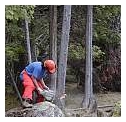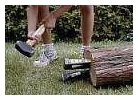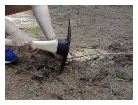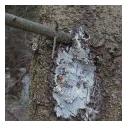 The wooden part of a birchbark canoe are almost all made of cedar. Cedar grows in swampy areas and on shallow dry soil and averages about 45 ft in height and 1 ft in diameter. Large trees may grow to 3 feet in diameter. It often grows in dense clumps. The wood is good for canoe building because it is light in weight, easy to split and bend and resistant to decay.
The wooden part of a birchbark canoe are almost all made of cedar. Cedar grows in swampy areas and on shallow dry soil and averages about 45 ft in height and 1 ft in diameter. Large trees may grow to 3 feet in diameter. It often grows in dense clumps. The wood is good for canoe building because it is light in weight, easy to split and bend and resistant to decay.
 Cedar is used for the gunwales, ribs and sheathing in the canoe. The longest pieces are the gunwales so a tree that is sufficiently long and straight must be found for them. For the ribs and sheathing, pieces that are about 5 feet long are long enough.
Cedar is used for the gunwales, ribs and sheathing in the canoe. The longest pieces are the gunwales so a tree that is sufficiently long and straight must be found for them. For the ribs and sheathing, pieces that are about 5 feet long are long enough.
Then the split pieces are split along the growth rings to make flatter pieces. The ribs are split roughly to shape, then finished with an axe, knife or other tools. The sheathing is split very finely until it is barely the thickness of a piece of thin cardboard. Splitting cedar is a wonderful process. It smells nice and sounds neat.
The initial splitting is done with splitting wedges, then an axe and a mallet can be used to start the split and the rest done by pulling the pieces apart with your hands. For the fine splitting, a knife is used to start the split. Getting cedar to split evenly must be practised a bit but is not hard if the wood is straight. If the split starts to go off centre, pull a bit more on the thicker side. In this picture I am starting a split with a hatchet, holding the wood between my legs to control the split.
 No nails or screws are used to hold a birchbark canoe together. Instead, the pieces are lashed together with peeled and split tree roots, usually from spruce trees, although pine roots can be used too.
No nails or screws are used to hold a birchbark canoe together. Instead, the pieces are lashed together with peeled and split tree roots, usually from spruce trees, although pine roots can be used too.
The pick axe is used at first to pull up a root. Then the root is gradually pulled out of the ground, following it as it goes under and over other roots. For a canoe, the roots need to be about the size of a finger. I also use smaller roots for model canoes.
The best place to get spruce roots is in sandy soil where the trees are not too close together. You will need roots about 6 feet long for each lashing.
 Spruce gum is used to seal the seams in a birchbark canoe and make it watertight. Spruce gum is the sap of the spruce tree. You can find it on the same trees that you get roots from. Where there is a wound in the tree the sap oozes out and dries to form a hard mass. I found many patches of oozing gum on the trees I looked at and in the middle of many of them was a grub which seemed to be burrowing into the tree. Click on the picture to see it bigger.
Spruce gum is used to seal the seams in a birchbark canoe and make it watertight. Spruce gum is the sap of the spruce tree. You can find it on the same trees that you get roots from. Where there is a wound in the tree the sap oozes out and dries to form a hard mass. I found many patches of oozing gum on the trees I looked at and in the middle of many of them was a grub which seemed to be burrowing into the tree. Click on the picture to see it bigger.
To collect the gum, scrape it off with a stick or old knife into a bucket or plastic bag. The gum has to be purified and mixed with a bit of fat (such as lard) before it is used. First melt it in an old pot until it is liquid. Then strain it through a cloth, squeezing it tight to get all the good gum out and leave the sticks, dirt and grubs(!) behind.